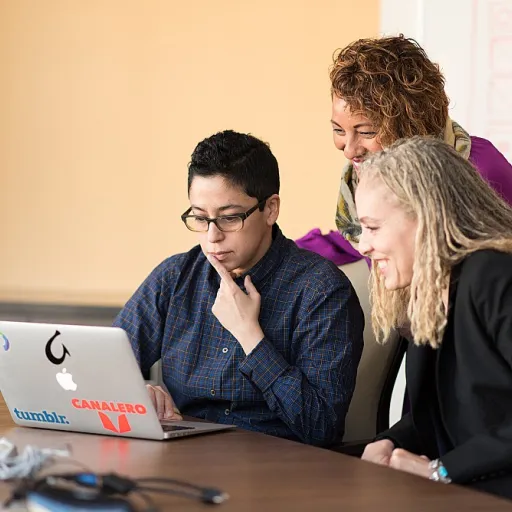
Understanding Team Dynamics
Decoding Team Dynamics for a Seamless Transition
Understanding team dynamics is crucial when transitioning into a new workplace. Each team has its own unique culture, shaped by the people, processes, and communication styles that define it. To integrate effectively, it's important to observe and learn how these elements interact. This will not only help you fit in but also contribute positively to the team.
One effective way to start is by observing how team members interact during meetings and casual conversations. Pay attention to the communication styles that are prevalent. Are they open and direct, or more reserved and formal? Understanding these nuances can help you tailor your approach to communication, ensuring that you are heard and understood.
Another aspect to consider is the existing workflows and processes. Every team has its own way of doing things, and adapting to these can be a challenge. However, by being open to learning and asking questions, you can quickly get up to speed. This not only helps you perform better but also shows your willingness to integrate into the team culture.
Building relationships with team members is also essential. Engaging in team building activities or informal gatherings can provide insights into the team dynamics and help you feel more connected. This sense of connection can enhance employee engagement and make you feel valued as a team member.
For more insights into navigating career transitions and understanding team dynamics, consider exploring this strategic approach to ensure a successful transition.
Building Relationships with Team Members
Fostering Connections in Your New Workplace
Building relationships with team members is crucial when transitioning into a new team. It not only helps you integrate smoothly but also enhances your overall work experience. Here are some effective ways to foster connections and create a supportive work environment:
- Be Open and Approachable: Approach your new colleagues with an open mind. Show genuine interest in their roles and experiences. This openness will help employees feel more comfortable around you and encourage them to share insights into the company culture.
- Participate in Team Building Activities: Engage in any team building exercises or social events. These activities are designed to merge teams and help employees connect on a personal level, which can be especially beneficial during a merger or acquisition.
- Seek Mentorship: Identify a team member who can act as a mentor. This person can provide guidance on navigating the workplace culture and offer support as you adapt to new workflows and processes.
- Encourage Open Communication: Foster an environment of psychological safety where team members feel valued and comfortable expressing their thoughts. Effective communication is key to building strong relationships and ensuring everyone is aligned with the team's goals.
- Contribute to Employee Engagement: Actively participate in discussions and offer your unique skills and experiences. This not only demonstrates your commitment to the team but also enriches the collective knowledge of the group.
By focusing on these strategies, you can create a positive and collaborative atmosphere that benefits both you and your new team. For more insights into effective succession planning and how it can impact your transition, you can explore this guide on succession planning.
Effective Communication Techniques
Mastering the Art of Transparent Discourse
The key to navigating a successful integration into a new team lies in effective ways to communicate. This involves more than just exchanging information; it's about understanding and embracing the team culture, and cultivating an environment where ideas flow freely.
Begin by familiarizing yourself with how people in your new workplace prefer to communicate. Is there a reliance on digital tools, or do teams favor face-to-face discussions? Understanding this will help you adapt and engage more effectively with team members.
Here are some strategies to enhance your communication skills in your new role:
- Listen Actively: Listening is just as important as speaking. By showing genuine interest in your colleagues' perspectives, you foster a sense of psychological safety and encourage open dialogue.
- Be Clear and Concise: When sharing information, ensure your points are clear and direct. This minimizes misunderstandings and establishes your credibility as a reliable communicator.
- Seek Feedback: Regularly ask for feedback from both team members and mentors. This will help you understand how your communication style impacts the team and identify areas for improvement.
- Embrace Open Communication: Encourage transparent communication by being open about your thoughts and feelings. This helps create an environment where team members feel valued and are motivated to share their own insights.
Remember, integrating into a new team during a merger or acquisition often involves adjusting to different communication styles and overcoming initial challenges. However, by adopting these techniques, you'll contribute positively to the building of a cohesive and successful team environment.
Adapting to New Workflows and Processes
Thriving Amidst New Systems
Adapting to new workflows and processes is crucial when joining a new team, whether due to a merger acquisition or simply switching jobs. The culture and daily operations of your new workplace might differ significantly from what you're used to. Here are some effective ways to acclimate efficiently and help the team succeed overall:- Learn and Understand the Systems: Take the time to fully understand the company's systems and workflows. This might require self-initiative or reaching out for mentorship within the team. Employees feel more integrated when they have the insights into how things work.
- Be Open to Learning and Feedback: Approach new processes with an open mind. Engaging with team members who are willing to help not only enhances your learning but also aids in building relationships with team members.
- Embrace a Customer Success Mindset: By viewing tasks from a customer success perspective, you become an asset to the team. This approach ensures that every action supports the broader goals of the company, contributing to team building and employee engagement.
- Work-Life Balance is Key: While adapting, remember the importance of maintaining a healthy work-life balance. This will not only help you stay productive but also demonstrate adaptability without burning out.
Leveraging Your Unique Skills
Highlighting Your Unique Contributions
When transitioning into a new team, leveraging your unique skills can greatly benefit both you and your team. By showcasing your skills and experiences, you not only help the team but also establish your place within the company culture. Making your capabilities known to team members can facilitate engagement and help practitioners appreciate how your background enriches the workplace dynamics.
Here are some effective ways to harness your talents:
- Identify your strengths: Reflect on the skills and experiences that make you an asset to your team. Are you skilled in customer success strategies, psychological safety, or team building? What past expertise can you offer your new colleagues?
- Share relevant insights: Organize knowledge-sharing sessions or mentorship meetings where you can present insights into areas like merger acquisition processes or market trends. By providing valuable information, you help employees and position yourself as a resourceful team member.
- Offer support: Be open to helping your colleagues in areas where you excel. Whether that involves communication techniques or streamlined processes, offering a helping hand can ease the transition for others and foster a sense of camaraderie.
Your unique contributions not only make you feel valued but also facilitate a smoother merger when new team members merge teams during a merger or acquisition. By capitalizing on what makes you unique, you can aid both team and company efforts effectively.
Seeking Feedback and Continuous Improvement
Continuous Feedback Loop: A Pathway to Growth
In any thriving workplace, feedback and continuous improvement form the backbone of personal and team success. Identifying effective ways to weave these practices into your daily routine can significantly impact your career transitions within the team.
One of the first steps toward creating a culture of feedback is fostering open communication. Encouraging team members to share their insights into projects helps in identifying areas that need improvement. This openness not only cultivates psychological safety but also ensures that all team members feel valued and heard.
In many successful teams, mentorship plays a vital role in employee engagement. Pairing up with a mentor can provide you with guidance and support as you navigate new workflows and adapt to the company culture. Regular check-ins with your mentor can help you stay aligned with the team's goals, see the impact of your contributions, and discover new skills experiences that can be applied effectively.
Building relationships with colleagues and team members by actively seeking their feedback creates a supportive environment. Employees feel more engaged knowing they have a stake in the team's development, thus, helping to merge teams seamlessly during transitions such as merger acquisitions.
Moreover, embracing learning as an ongoing process is crucial. Engage in activities that help to refine your skills and adapt to new market demands. Whether through formal training sessions or casual team building exercises, continuous learning fosters growth, which ultimately benefits individual employees and the team as a whole.
Remember, feedback should not only come from top-down structures. Instead, encourage a 360-degree feedback mechanism where every team member has the opportunity to provide and receive constructive criticism, ensuring customer success and a thriving workplace environment.












